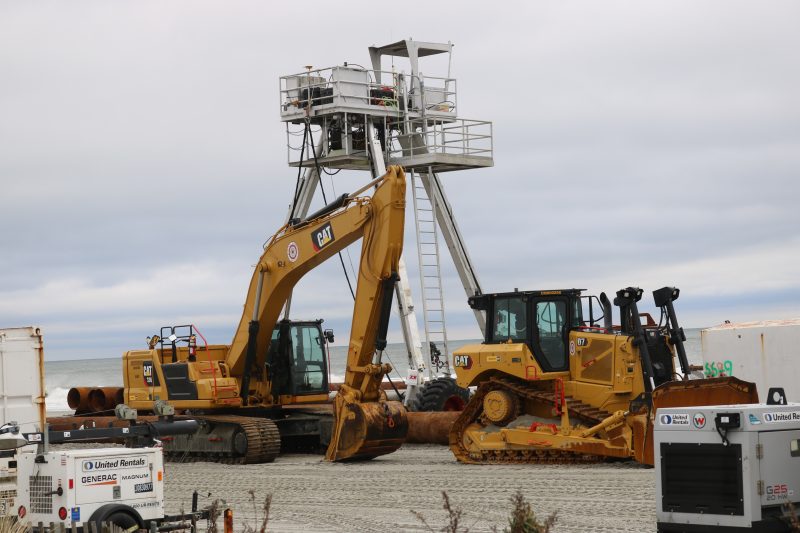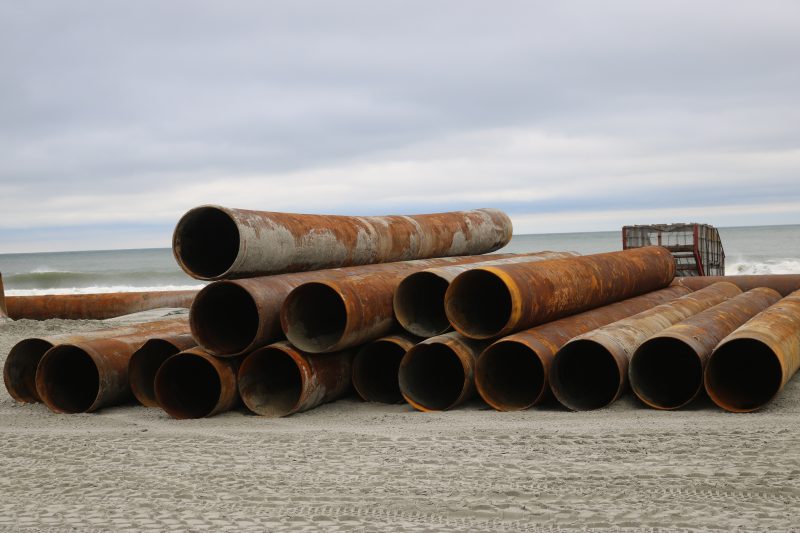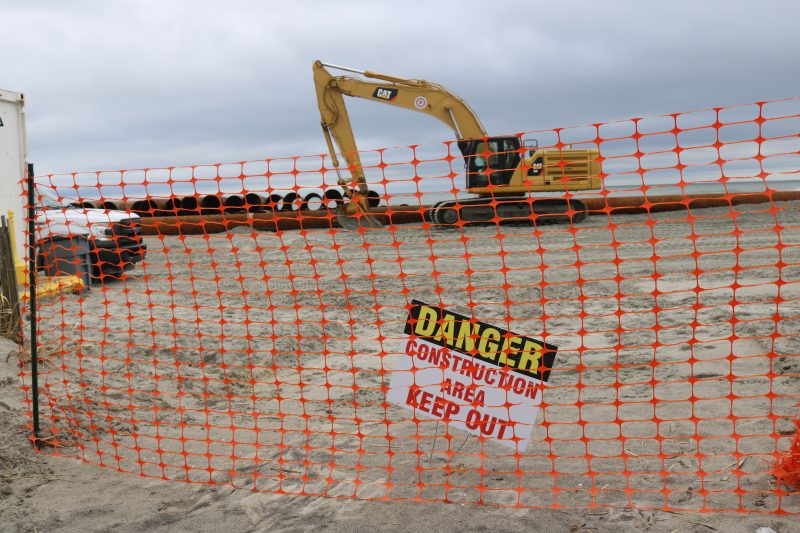Sand will be pumped through these massive pipes.
 By MADDY VITALE
By MADDY VITALE
When 39-degree temps and gloomy clouds bring on the winter blues, there is something to smile about -- wide sandy beaches in Ocean City come summer -- thanks to an ongoing beach replenishment project.
The project began in November to pump in 1.5 million cubic yards of fresh sand in the north end and the downtown area stretching from the Seaview Road jetty to 14th Street.
On Monday, heavy construction equipment, including the CRAB, “Coastal Research Amphibious Buggy,” was assembled on the beaches near the Music Pier for the nearly $24.4 million project to pump sand onto the eroded shoreline.
Ocean City Public Information Officer Doug Bergen said there are about five or six days of pumping left until the project reaches the southern terminus near 14th Street.
"Work will then return to areas from Fourth Street northward to touch up sections of the beach and deposit the full amount of the contracted 1.5 million cubic yards of sand," Bergen said. "All pumping is contingent on ocean conditions, but the project remains on schedule to be completed by mid-February."

Sand will be pumped through these massive pipes.
The cost of the beach project will be split between the Army Corps of Engineers, the New Jersey Department of Environmental Protection and Ocean City. The Army Corps, a federal agency, will pay most of the cost. Great Lakes Dredge and Dock Company is the contractor hired by the Army Corps to do the major replenishment project.
“As always, Ocean City is grateful for this partnership with the Army Corps and state DEP to protect our property and keep our beaches and dunes healthy,” Bergen said.
A big, floating dredge, named Texas, is anchored offshore to pump sand from the Great Egg Harbor Inlet onto the beaches through a system of massive pipes.
The most attention-grabbing piece of equipment is the towering CRAB perched on three legs. It plays a key role in the beach replenishment project. Moving along both in the water and on land, it deploys instruments on the bottom of the ocean, collecting data to monitor the progress of the project, according to the Army Corps of Engineers.
In addition to the 1.5 million cubic yards of sand, Ocean City is exercising an option in the contract for four stockpiles of sand. It would mean an additional 10,000 cubic yards of sand in total for use after the replenishment project is completed, officials have said.

Beach access is restricted at work sites.
In a statement Friday, Mayor Jay Gillian cautioned the public about the work sites.
“I want to remind everybody that beach access is restricted in the areas where the Army Corps of Engineers is working on the current replenishment project,” Gillian said.
He continued, “For your own safety and to allow the contractor to operate its heavy equipment unhindered, please do not cut through the work area to get to the ocean. And do not disregard the instructions of the personnel monitoring access to the work site. Police will strictly enforce these restrictions.”
Beach restoration in Ocean City initially was done in 1992 and continues on a three-year cycle under a 50-year agreement between the town and the Army Corps of Engineers.
This is the 10th replenishment project for the north end of Ocean City since the 50-year agreement with the Army Corps began in the early 1990s, officials said.
As of Monday, beach access was closed at Plymouth Place, Eighth Street and Moorlyn Terrace. Access to 1,000 feet of beach surrounding work areas will be restricted at any time as work moves southward toward 14th Street.
Daily updates on which beach access points are closed are available at www.ocnj.us/BeachReplenishmentUpdate.

The work will continue south of the Music Pier to 14th Street.
 By MADDY VITALE
When 39-degree temps and gloomy clouds bring on the winter blues, there is something to smile about -- wide sandy beaches in Ocean City come summer -- thanks to an ongoing beach replenishment project.
The project began in November to pump in 1.5 million cubic yards of fresh sand in the north end and the downtown area stretching from the Seaview Road jetty to 14th Street.
On Monday, heavy construction equipment, including the CRAB, “Coastal Research Amphibious Buggy,” was assembled on the beaches near the Music Pier for the nearly $24.4 million project to pump sand onto the eroded shoreline.
Ocean City Public Information Officer Doug Bergen said there are about five or six days of pumping left until the project reaches the southern terminus near 14th Street.
"Work will then return to areas from Fourth Street northward to touch up sections of the beach and deposit the full amount of the contracted 1.5 million cubic yards of sand," Bergen said. "All pumping is contingent on ocean conditions, but the project remains on schedule to be completed by mid-February."
By MADDY VITALE
When 39-degree temps and gloomy clouds bring on the winter blues, there is something to smile about -- wide sandy beaches in Ocean City come summer -- thanks to an ongoing beach replenishment project.
The project began in November to pump in 1.5 million cubic yards of fresh sand in the north end and the downtown area stretching from the Seaview Road jetty to 14th Street.
On Monday, heavy construction equipment, including the CRAB, “Coastal Research Amphibious Buggy,” was assembled on the beaches near the Music Pier for the nearly $24.4 million project to pump sand onto the eroded shoreline.
Ocean City Public Information Officer Doug Bergen said there are about five or six days of pumping left until the project reaches the southern terminus near 14th Street.
"Work will then return to areas from Fourth Street northward to touch up sections of the beach and deposit the full amount of the contracted 1.5 million cubic yards of sand," Bergen said. "All pumping is contingent on ocean conditions, but the project remains on schedule to be completed by mid-February."
 Sand will be pumped through these massive pipes.
The cost of the beach project will be split between the Army Corps of Engineers, the New Jersey Department of Environmental Protection and Ocean City. The Army Corps, a federal agency, will pay most of the cost. Great Lakes Dredge and Dock Company is the contractor hired by the Army Corps to do the major replenishment project.
“As always, Ocean City is grateful for this partnership with the Army Corps and state DEP to protect our property and keep our beaches and dunes healthy,” Bergen said.
A big, floating dredge, named Texas, is anchored offshore to pump sand from the Great Egg Harbor Inlet onto the beaches through a system of massive pipes.
The most attention-grabbing piece of equipment is the towering CRAB perched on three legs. It plays a key role in the beach replenishment project. Moving along both in the water and on land, it deploys instruments on the bottom of the ocean, collecting data to monitor the progress of the project, according to the Army Corps of Engineers.
In addition to the 1.5 million cubic yards of sand, Ocean City is exercising an option in the contract for four stockpiles of sand. It would mean an additional 10,000 cubic yards of sand in total for use after the replenishment project is completed, officials have said.
Sand will be pumped through these massive pipes.
The cost of the beach project will be split between the Army Corps of Engineers, the New Jersey Department of Environmental Protection and Ocean City. The Army Corps, a federal agency, will pay most of the cost. Great Lakes Dredge and Dock Company is the contractor hired by the Army Corps to do the major replenishment project.
“As always, Ocean City is grateful for this partnership with the Army Corps and state DEP to protect our property and keep our beaches and dunes healthy,” Bergen said.
A big, floating dredge, named Texas, is anchored offshore to pump sand from the Great Egg Harbor Inlet onto the beaches through a system of massive pipes.
The most attention-grabbing piece of equipment is the towering CRAB perched on three legs. It plays a key role in the beach replenishment project. Moving along both in the water and on land, it deploys instruments on the bottom of the ocean, collecting data to monitor the progress of the project, according to the Army Corps of Engineers.
In addition to the 1.5 million cubic yards of sand, Ocean City is exercising an option in the contract for four stockpiles of sand. It would mean an additional 10,000 cubic yards of sand in total for use after the replenishment project is completed, officials have said.
 Beach access is restricted at work sites.
In a statement Friday, Mayor Jay Gillian cautioned the public about the work sites.
“I want to remind everybody that beach access is restricted in the areas where the Army Corps of Engineers is working on the current replenishment project,” Gillian said.
He continued, “For your own safety and to allow the contractor to operate its heavy equipment unhindered, please do not cut through the work area to get to the ocean. And do not disregard the instructions of the personnel monitoring access to the work site. Police will strictly enforce these restrictions.”
Beach restoration in Ocean City initially was done in 1992 and continues on a three-year cycle under a 50-year agreement between the town and the Army Corps of Engineers.
This is the 10th replenishment project for the north end of Ocean City since the 50-year agreement with the Army Corps began in the early 1990s, officials said.
As of Monday, beach access was closed at Plymouth Place, Eighth Street and Moorlyn Terrace. Access to 1,000 feet of beach surrounding work areas will be restricted at any time as work moves southward toward 14th Street.
Daily updates on which beach access points are closed are available at www.ocnj.us/BeachReplenishmentUpdate.
Beach access is restricted at work sites.
In a statement Friday, Mayor Jay Gillian cautioned the public about the work sites.
“I want to remind everybody that beach access is restricted in the areas where the Army Corps of Engineers is working on the current replenishment project,” Gillian said.
He continued, “For your own safety and to allow the contractor to operate its heavy equipment unhindered, please do not cut through the work area to get to the ocean. And do not disregard the instructions of the personnel monitoring access to the work site. Police will strictly enforce these restrictions.”
Beach restoration in Ocean City initially was done in 1992 and continues on a three-year cycle under a 50-year agreement between the town and the Army Corps of Engineers.
This is the 10th replenishment project for the north end of Ocean City since the 50-year agreement with the Army Corps began in the early 1990s, officials said.
As of Monday, beach access was closed at Plymouth Place, Eighth Street and Moorlyn Terrace. Access to 1,000 feet of beach surrounding work areas will be restricted at any time as work moves southward toward 14th Street.
Daily updates on which beach access points are closed are available at www.ocnj.us/BeachReplenishmentUpdate.
 The work will continue south of the Music Pier to 14th Street.
The work will continue south of the Music Pier to 14th Street.